I noticed this picture because the woman in the image is my great-aunt, First Lady Lee Hee-ho. Apparently she loved the color purple and that this fabric was dyed with sweet potatoes, so her husband (President Kim Dae-jung) said that these color traditions needed to be safeguarded and to build a museum. All I could think about afterwards was a small silk purple pouch that she gave to my mom on a visit to NYC many years ago. My mom let me have it and it's holding electrical cables and whatnot in a box back home.
That may have been the start of my adventure, as then I was introduced with that family connection, to the director of the museum, who took me out for a giant Korean lunch with so much banchan that I couldn't even reach a bunch of the plates. This is before the main dish appeared.
It was a shame that there were only three of us, because that was a LOT of grilled fish. I was so happy to finally be able to eat this well with other people, as Jeolla Province is incredibly well known for its food culture. Afterwards, we had tea at the 'senior cafe' attached to the museum, and I overheard the elderly woman working the counter try to fix her mistake of running a card for 80,000 won rather than 8,000 won (pretending a more basic exchange rate, $80 instead of $8). While this was being sorted out, the museum director insisted that I spend the night at his home with his wife as they host foreign artists all the time and she is also an artist. I said no, I only packed for a day trip and have nothing for an overnight, but was not smart enough to say I had appointments the following day, so I was roped into something I knew was a bad idea.
Now captive, Dr. Heo took me on a whirlwind tour of the premises, except I never got to see the inside of the natural dyeing museum save the part we walked past to get outside to lunch. Instead, we saw all kinds of things related to the Jeonnam Craft Center, including this woodshop that seemed brand new. [n.b.: "Jeonnam" refers to the name of the region, as the province is called Jeollanam-do, which translates exactly to "Jeolla + south + province" and can be shortened to Jeonnam. It makes more sense if you can read the Korean characters.]
Due to pandemic, the site was empty, but this is a whole room for kids to have a hanji experience.
I go crazy whenever I see classrooms set up for water: stainless sinks, floor drains, the works. These are for dyeing.
A CNC router in the wood shop as well!
And even a separate box container for lacquer work, with this temperature/humidity-controlled unit for proper polymerization.
At the gallery/studio/grounds of the indigo dyeing intangible cultural property holder Jung Gwan-chae (I was not able to meet him and his son as they were not there when Dr. Heo took me to visit but his wife showed us around). Thanks to Youngmin for sharing this video of the indigo master.
The pots are for indigo, not for food storage and fermentation as you might assume in a Korean setting.
The grounds are immaculate and you can see the oyster shells in the background for the necessary calcium in the Korean indigo process. In the foreground, plants to be burned to create ash for the necessary alkali.
Looking out from the property to the road, and beyond that, farmland.
In the ginormous studio with super high ceilings and fabric hung to dry. It was going to rain the next day.
More giant containers for indigo
OMG this was wild. This is also a GIANT receptacle for indigo, probably the size of a NYC studio apartment, if not larger. Set under the floor level of the building and equipped with a mixer on the side.I was too distracted to get his wife's name (because at this point, I'm worried about why in the world I have to spend the night with strangers and what is going on in general as no one told me the day's schedule. I know, so very American of me to be so plan-oriented), but she showed us this lovely lamp whose petals are fabric on one side and paper on another, I think.
She made a lot of the jogakbo in the gallery and her stitching is tiny and immaculate. Looking at it made my eyes hurt because the work is so fine.
Work by another artist, where the hanji is pasted in layers over an indigo-dyed base.
By yet another artist, reproducing the deep indigo and gold illumination of old Buddhist sutras.
The gallery space was lovely and chock full of all kinds of different artwork.
I forgot if this was fabric or paper dyed with indigo as the base for the screens.
I love this way of hanging fabric under lights
This beautiful screen was made by the national intangible cultural property holder in bamboo screen making (as in jukryeom, blinds to hang in windows and homes, not for making hanji) who lives in Tongyeong.The bamboo was first dyed here and then splints sent back to Tongyeong to weave.
This was on the second floor, which is one wide open space but still with plenty to see.
Downstairs in a smaller room off the front I saw these, almost a tease, because I want a set of these beating sticks and platform so badly! But even if I found something similar, it would be too heavy to bring home.
Inside, near the stairs, I was so surprised. Have you ever seen a jade plant flower? I have never, so this was a treat.
In general, blossoms EVERYWHERE.
I don't know if I appreciate this more after buying a home and having to worry about the land around it, or because I'm getting older, or what. But I love seeing all these different plants everywhere I go, as in different from what's native back home.
Dr. Heo then drove me nearby to the tombs museum. There are tombs right along the rural road in the middle of fields being farmed. They had fake animals all over this place! And not taxidermy to look real but like cute little stuffed animals. Whether for scale or to break the monotony, I don't know. I didn't take any pictures of them and we walked through in a big hurry but it went along with the way that Korean locations will intersperse cartoonish figures in places I wouldn't expect them.
We also visited an intangible cultural property holder of furniture making, so quickly that I didn't even get to shoot him properly or the inside of his showroom where you can see the actual pieces. His son is at right and this is the workshop from what I could tell. I was given more advice on bamboo knives and so on, plus gossip that only intangible cultural property holders know because they hang out with each other during non-pandemic times.
Then at the museum the director said he was too busy to accompany me to meet his wife so a museum employee drove me way into the mountains. I had no idea where we were but we weren't in Naju anymore.
Mr. Kim (left) was kind enough to leave me with an umbrella; I had said I only intended to do a day trip expressly because I knew that the rain would begin the next day, which I wanted to avoid. It was an extremely kind and necessary gesture, and it was a brand-new umbrella. Now I have three, and I arrived in country with zero. Here, Park Young-hee is showing her artwork to Mr. Kim in the gallery portion of her beautiful and peaceful haven that includes a cafe/showroom and studio in her building. There is another building where her husband does natural dyeing and has his library/office.
Every bit of the space is considered, not only inside but outside (you can see the old tiles on the balcony placed so that you can enjoy the view from inside), and her artwork is everywhere, from ceramics to textiles to clothing and so on.
All of her artwork is made from naturally-dyed fabrics, like the mountain landscape above all of the clothes that she designs and then has made from fabrics that she and her husband dye.
This is the gallery section and I loved the view of the bamboo outside the window. When she has exhibits, she takes props like the old beautiful wood chest in the corner to create the right atmosphere.
The three pieces in the center white gap are pieces of ceramic art that she makes. The rest is dyed fabric, burned and sewn.
These are all separate panels so you can mix and match, I think.
The white orchids had the most gorgeous scent; these are on the floor near the café/showroom entrance.
The view from her sewing machine is lovely, and we had walked along the path beyond the trees to visit the new bakery and walk through a protected wooded area that had all kinds of plants coming up in the understory, which was a much lovelier landscape than grass.
She finds things like old doors (you can tell from the bits sticking out of the corners) and turns them into worktables.
Dyed fabrics as well as bedding that she has made from the fabrics she dyes. I slept on and under similar bedding.
She makes delicious food, seasonal and thoughtful. For lunch, we had a couple of pastries and she made a salad that included leaves she picked from trees outside and nutritious plants that people like me would walk right by. She is extremely hardworking, and I was amazed by how she managed all of the housework and artwork while caring for a child with special needs for the rest of her life. I was supposed to get a ride the next day to the bus terminal in Gwangju (which of course I didn't know until the next day, so I had been on my phone at night looking up where I actually had been taken, as I had no idea, and saw there was no easy way for me to get back home). What started the prior afternoon continued, where the person who invited me to his home disappeared and never reappeared again, so Mrs. Park had to drive me towards the terminal. She wasn't comfortable driving all the way to the terminal because it's city driving but as it started to rain even harder, she felt badly and said she would go all the way, only to change her mind when someone called to say they were at the café and it was locked. She runs it herself with no employees.
She left me on the side of the road to walk to the bus stop up the street or catch a cab, which wasn't a real option because there are never empty cabs on rainy days. I waited 15 minutes for the bus but it was only a few stops to the terminal. I pressed the wrong button while buying my ticket so I had to wait two hours for the bus but had already been there twice before on another sideways trip, so I knew where to order a good soup. I was so happy to get home but only stayed one night before heading to Seoul to see my family and get the rest of my luggage I stored with them as I couldn't hand carry it to Jeonju before. I arrived after lunch, so my cousin very kindly and speedily cooked up one of his famous bowls of ramen.
He recommended a hotel near his home that I had seen but hadn't booked before because I thought my family wouldn't want me that close. I couldn't get a refund on the hotel I booked for two nights in a location a bit further away, but was SO tired and really just wanted to be close to family and be taken care of, so I paid the cancellation fee and booked down the street. Though the bedding and amenities at the cancelled hotel were better, it was a great decision. I had the rest of my meals with family, including this takeout kimbab at a local place that loads lots of veggies (the greens are my favorite: perilla leaves) and doesn't have a lot of rice, so popular with young women trying to stay slim. Not that any of us were worried about that. It was a feast that lasted less than 48 hours, and then I was off on a train back to my dorm room.
I thought I was going to finish this post days ago but then got caught up in another last-minute trip. The adventures never cease, so this afternoon is my one breather. Happy weekend!









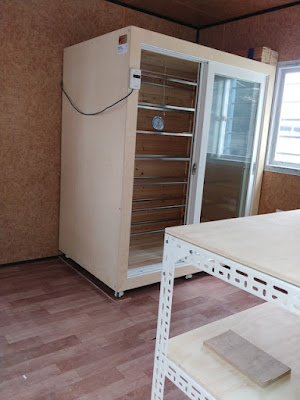


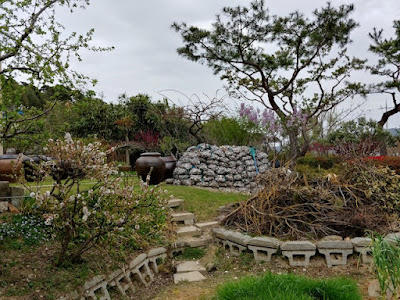







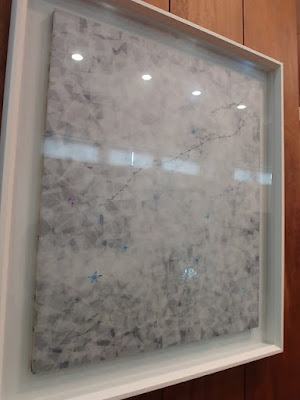




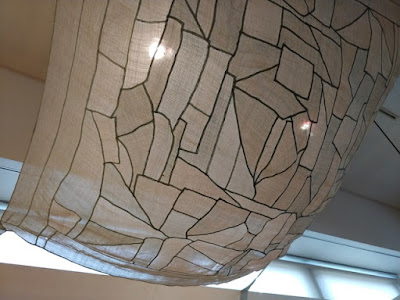








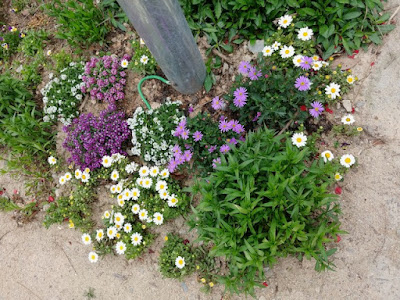













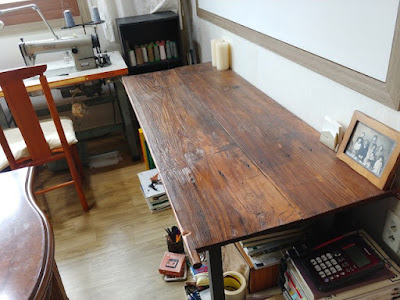

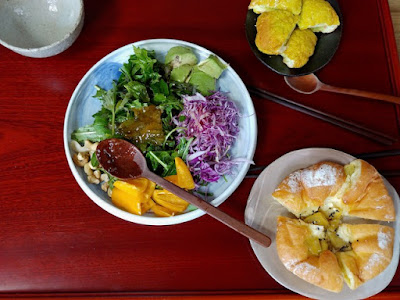

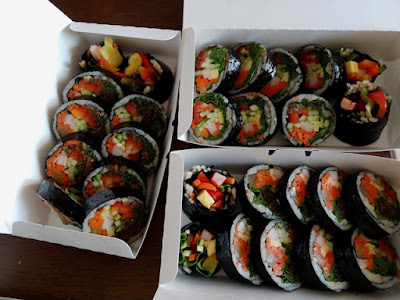
No comments:
Post a Comment